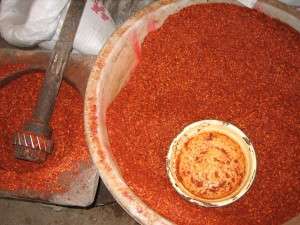
In October 2005, I spent a day in Luodai, a picturesque Hakka suburb of Chengdu, capital of the Sichuan province. I was there collecting information and recipes for my Hakka cookbook. This town houses many guilds from different provinces in China. The guilds function as social halls with restaurants, tea houses, and meeting rooms. Donations from Hakka from these provinces built these guilds. We eat two Hakka banquets, one at the Jiangxi Guild, and a second one at the Guangdong Guild.


One ingredient that appeared in several dishes in both banquets were mushrooms. Mushrooms grow in the mountains nearby. We saw many mushrooms for sale in town. One dish that was served at both banquets was braised mushrooms. It was a relatively straightforward dish that emphasized the pure, earthy mushroom essence. The mushrooms were simply braised in broth, with garlic, ginger, and leek. It’s an easy dish for the home cook. This is a description on how to make the dish. For a more detailed recipe, see The Hakka Cookbook, page 70.
Braised Mountain Mushrooms
Clean about 12 ounces fresh mushrooms (use one or several types). Discard stems from shiitake. Slice the mushrooms about 1/2-inch thick. If pieces are large, cut mushroom slices in 2- 3-inch lengths. Clean1 leek or 2 or 3 green onions, and thinly slice. Cut 2 or 3 large garlic cloves and a1-inch piece of fresh ginger into thin slices.
In a large wok or frying pan over medium-high heat, add 2 tablespoons vegetable oil. Add leek, garlic, and ginger and stir-fry until leek is limp, about 30 seconds, then add mushrooms. Stir-fry until mushrooms are lightly browned, 2 to 3 minutes. Add 1 cup chicken or vegetable broth, 2 tablespoons Chinese rice wine (shaoxing) or dry sherry, 1 tablespoon soy sauce, ¼ teaspoon salt, and ⅛ teaspoon ground white pepper. Bring to a boil, reduce heat, cover and simmer, stirring often until mushrooms are limp, 2 to 3 minutes. Mix 2 tablespoons water with 1 tablespoon cornstarch and add to pan. Stir until the sauce boils. Transfer to serving dish. Makes 4 to 6 servings.





